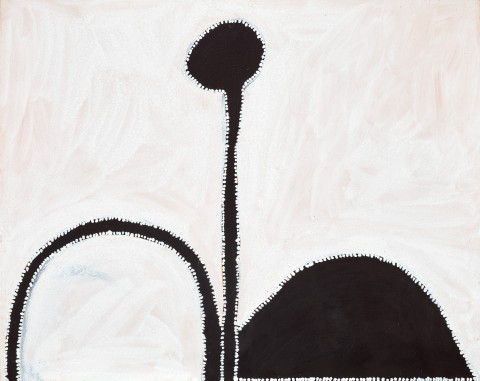CAMEL GAP, 2004
PADDY NYUNKUNY BEDFORD
ochres and pigments with synthetic binder on composition board
80.5 x 100.5 cm
signed with initials verso: PB
bears inscription verso: Jirrawun Arts cat. PB CB 3-2004-17
Jirrawun Arts, Kununurra, Western Australia
The Estate of Paddy Bedford
Bonhams, Sydney, 21 November 2011, lot 3B
Private collection, Sydney
Paddy Bedford: Crossing Frontiers, Museum of Contemporary Aboriginal Art (AAMU), Utrecht, The Netherlands, 8 October 2009 - 11 April 2010
Storer, R., Paddy Bedford, Museum of Contemporary Art, Sydney, 2006, p. 161 (illus.)
Petitjean, G., et al., Paddy Bedford: Crossing Frontiers, Museum of Contemporary Aboriginal Art (AAMU), Utrecht, The Netherlands, and Snoeck Editions, Heule, Belgium, 2009, p. 95 (illus.)
Camel Gap, 2004, ochres and pigment on linen, 150.0 × 180.0 cm, in the collection of the Museum of Contemporary Art, Sydney donated through the Australian Government’s Cultural Gifts Program by Colin and Elizabeth Laverty, 2012
‘Paddy Bedford’s paintings articulate a complex dialectic between modern materials and traditional pictorial conventions, contemporary experience, and ancient belief systems’.1
Drawing from two very different sources of knowledge, and painting with a deep sense of history and cultural responsibility, Paddy Bedford mapped the rich history of the east Kimberley using stories from his father’s, mother’s and uncle’s country. Within his canvases, historical events together with the more mundane stories about daily life on cattle stations co-exist with profound and lyrical understanding of the land and its creation stories. Bedford explored the important stories from its past whilst painting the bones of the landscape with the waterholes, stockyards and roads that he traversed throughout his life. Painted in 2001, Camel Gap, documents an evolution in the artist’s painting style, moving beyond the more familiar ochre representations of country produced by earlier East Kimberley artists, and predicting his further innovative changes in palette and technique.
Camel Gap, also known as Gernawarliyan to the local Gija people, is found in the traditional country of the artist’s mother. Located to the south-east of Bedford Downs station and adjacent to Marty’s bore, a few kilometres east of the Springvale – Lansdowne Road, it is a place where in mythological times, the goanna Garndoowoolany camped in the ngarranggarni (Dreaming). Garndoowoolany called out to Marranyi, the dingo, whom he saw at the top of the hill. It was here that Marranyi got stuck and became part of the rock. Its English name refers both to the shape of the hill and, also to the Afghan cameleers who, in the early twentieth century, travelled past this place on their journey south from the port at Wyndham to remote Kimberley communities and further afield for trade.
1. Michael Dolk cited in Storer, R., ‘Paddy Bedford’ in Michael, L., Paddy Bedford, Museum of Contemporary Art, Sydney 2006, p. 11
CRISPIN GUTTERIDGE
